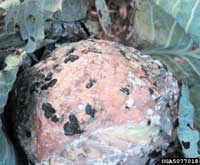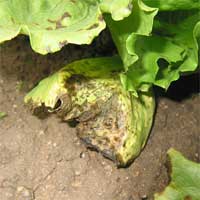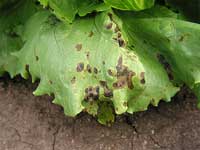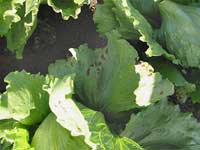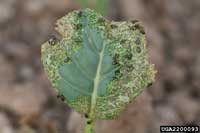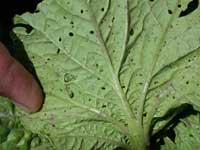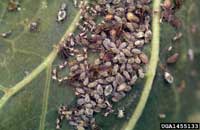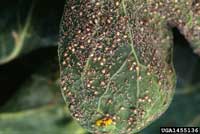Extension > Garden > Diagnose a problem > What's wrong with my plant? > Vegetable > Lettuce and Endive > Plant Wilts
Lettuce and Endive > Whole plant > Plant Wilts
1 of 4
White Mold (aka Lettuce Drop)
Sclerotinia sclerotiorum and Sclerotinia minor
- Plant wilts and outer leaves drop to the ground
- Base of the outer leaves are tan and water soaked
- Rot progresses into the heart of the head
- White cottony mold with small hard, black raisin like fungal structures can be seen at the base of the plant
2 of 4
Bacterial Leaf Spot
Xanthomonas campestris pv. Vitians
- Leaf spots are angular and water-soaked; quickly turn black
- Leaf spots grow together and leaf wilts
- Common in cool moist conditions
- More information on Bacterial Leaf Spot
3 of 4
Flea Beetles
Disonycha xanthomelas, Systena blanda, and Phyllotreta spp.
- Heavy feeding may cause wilting
- Adult feeding on leaves creates shallow pits and small, irregular holes giving it a "shot hole" appearance
- Adults are small (1/16 to 1/8 inch long), and vary in color from black, bronze, bluish, or brown to metallic gray, while some species have stripes
- Present throughout the growing season
- More information on Flea Beetles
4 of 4
Green Peach Aphid and Turnip Aphid
Myzus persicae, Lipaphis erysimi
- Feeding by larger numbers of aphids can cause curling, stunting, and wilting of leaves
- Feeding by small or moderate numbers of aphids usually does not cause visible symptoms
- Small insects (1/10th inch long), pear-shaped, usually greenish; clustered on underside of leaves
- Active during spring and summer
- More information on Green Peach Aphid and Turnip Aphid




